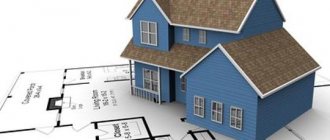In what cases is a house considered unsafe?
The definition of emergency housing is given by the Methodological Manual MDK 2-04.2004. This is a house in which load-bearing structures and more than half of the premises pose a danger to others.
The grounds for recognizing an object as emergency can be:
- natural wear and tear;
- influence of external factors;
- deformation;
- loss of design strength.
Expert opinion
Stanislav Evseev
Lawyer. Experience 12 years. Specialization: civil, family, inheritance law.
As a result of these impacts, strengthening measures must be taken. However, if the cost of restoration work exceeds the established standards, then the object is subject to demolition.
There is no need to confuse emergency and dilapidated housing. The main sign of dilapidation of a room is a high percentage of wear and tear. An object with a high percentage of wear and tear (70% or more) is considered dilapidated.
However, dilapidated housing does not pose a danger to the life and health of residents. While emergency - poses a danger to residents.
Thus, the dilapidated facility is subject to major repairs. And the emergency one is subject to demolition.
Which house is classified as “emergency”?
It is advisable to understand in detail which objects are subject to demolition and which are subject to reconstruction. In most cases, houses that are no longer feasible to repair are considered unsafe. This may be due to technical or economic nuances when it is unprofitable or impossible to carry out restoration work.
Emergency buildings are characterized by poor load-bearing capacity and low performance indicators. This poses a threat to the safety of people and the safety of engineering equipment.
Standard signs of a residential building being in disrepair:
- settlement of the middle part of the structure as a result of soil soaking due to faulty underground communications and drainpipes;
- settlement of the outer part of the house due to an open pit/trenches nearby, construction of a new building nearby;
- settlement of both extreme parts of the object - the presence of a large boulder, an old foundation, a well under the middle of the house;
- bulging and curvature of walls in vertical and horizontal planes.
When a house is considered unsafe, it is strictly prohibited to stay in it.
Criteria for recognizing housing as unfit for habitation
Residential premises fall into disrepair gradually or relatively quickly due to natural disasters. The following grounds are provided for recognizing an apartment building as an emergency:
- Deterioration in the operational characteristics of the building as a whole or its individual parts due to the physical wear and tear of the house. This reduces the level of reliability, strength and stability of the building structure.
The combination of several criteria implies the immediate recognition of an apartment building as unsafe and subject to demolition.
Differences between dilapidated and emergency housing
Emergency apartments are unsuitable for habitation and are almost always demolished. They are located in prefabricated stone, brick, and wooden houses with serious deformations of the foundations and walls. These signs indicate that the building has exhausted its load-bearing capacity. The main reason for deciding to demolish the premises is the high risk of structural collapse.
This is important to know: Powers of the general meeting of owners of an apartment building
The main difference between dilapidated housing and emergency housing is the relative safety of living. The house is in poor condition, but not critical.
Residents of emergency premises must be resettled, which cannot be said about the owners and tenants of apartments in a dilapidated building.
Another indicator of how dilapidated housing differs from emergency housing is the percentage of wear and tear. It is determined by an expert commission. To recognize a premises as dilapidated, it must exceed 70%, but to recognize it as unsafe, this is not enough. It must also pose a danger to residents.
In many regions of the Russian Federation, major repairs in dilapidated houses are not provided for with public funds. As a result, residents of worn-out apartment buildings find themselves at a disadvantage: living conditions do not meet standards, but they can live in the building.
The definition of “dilapidated” is not fixed at the legislative level. You can find more information in supporting documents, for example in the “Methodological manual for the maintenance and repair of housing stock MDK 2-04.2004”.
Grounds for recognizing housing as unsafe
The grounds for recognizing a residential property as unsafe are set out in Decree of the Government of the Russian Federation No. 47 of 2006 (Chapter 3).
| No. | Premises considered dangerous and subject to demolition | Comments |
| 1 | Premises located under a garbage chute or waste disposal device | An apartment is considered unsafe if under it or in an adjacent room there is a device for flushing or cleaning the garbage chute |
| 2 | Premises with windows overlooking noisy traffic routes, if the noise level cannot be reduced | The maximum permissible noise level is 55 dB during the day and 45 dB at night |
| 3 | Premises located in houses that suffered from natural disasters and cataclysms | The main condition is the unprofitability of repair work |
| 4 | Objects located close to overhead power lines | The maximum voltage value cannot exceed 1 kV/m, and the induction value cannot exceed 50 µT at an industrial frequency of 50 Hz |
| 5 | Objects located in the zone of possible man-made disasters | If it is impossible to protect the residential premises from destruction |
| 6 | Objects located in the zone of landslides, mudflows, avalanches or subject to flooding | An exception is the situation when flooding can be prevented with the help of engineering structures |
| 7 | Premises located in areas with negative sanitary and epidemiological indicators (electromagnetic fields, noise, vibration), if the indicators exceed the standards for citizens’ residence | These also include facilities located in areas of transport and engineering infrastructure, production and sanitary protection zones. |
| 8 | Apartment buildings with deformed foundations | These also include objects with deformed walls and wooden structures |
| 9 | Objects with a significant percentage of physical wear and tear, if this has led to the impossibility of safe use for residential purposes | If the level of reliability of supporting structures is significantly reduced, as a result of which strength and reliability are reduced |
Important! In everyday life, it is believed that housing can be considered unsafe due to its age. However, in practice, the age of the residential premises has no relation to establishing the breakdown of the apartment. The main sign is wear and tear.
In addition, the following indicators are not grounds for recognizing an object as dangerous:
- Lack of an elevator and garbage chute in an apartment building with more than 5 storeys.
- Compliance of the space-planning solution with outdated regulations, if this does not interfere with the normal operation of the facility.
- Lack of water supply and sewerage in the house, up to 2 storeys.
What are the consequences if an apartment building is declared unsafe?
There are some differences between the concepts of “dilapidated” and “emergency” housing. In the first case, the house has pronounced parts of structural failure. In percentage terms, this is no more than 40%. This can happen to a room that has fallen into a similar state over time. This is a completely natural situation.
Housing may be considered unsafe if:
- suffered from natural disasters;
- was subjected to external factors of destruction (for example, explosions);
- does not meet technical and sanitary standards.
The criteria for recognizing a house as unsafe are described here.
Emergency housing can only be demolished, while dilapidated housing can still go through the stage of reconstruction and again serve people as living quarters.
According to Government Decree No. 47, a house can only be recognized as dilapidated or in disrepair by a specially established commission, which will decide on repairs or demolition (what should residents do to ensure that the house is recognized as in disrepair?).
IMPORTANT. In any case, relocation of residents will be required. Even if the house requires major repairs, the owners must leave the occupied apartments for a while.
The difficulty lies in the fact that there is no such condition as “dilapidated” in the concept of the Housing Code . Therefore, this type is regulated by the decision of self-government bodies and an interdepartmental commission (consisting of employees of different government bodies: Rospotrebnadzor, self-government bodies, urban planning department, etc.).
Within a month, the municipality must adopt an appropriate order recognizing the house as unsafe and dilapidated housing (what are the features of this procedure?).
The procedure for recognizing housing as unsafe
Responsibilities for recognizing residential facilities as unsafe are assigned to local governments. Each municipality is obliged to form a specialized commission under the housing committee of the local administration.
The composition and work of the interdepartmental commission are approved by a resolution of the local government body.
The powers of the interdepartmental commission for recognizing housing as unsafe include:
- acceptance of documents;
- defining a list of additional documentation;
- recruitment of experts;
- inspection of the facility;
- making a decision to recognize the house as unsafe;
- refusal to assign an emergency status to an object.
The initiation of the process rests with the residents or owners. Local government specialists are not required to independently inspect each house without the residents’ application.
Procedure:
- Collection of documentation.
- Contacting the authorized body.
- Receipt of the act.
What documents are needed for registration?
The preparation of documents for recognition of housing as unsafe is established by local regulations of the municipality. The general list is contained in Decree of the Government of the Russian Federation No. 47 of 2006 (Article 45).
List of documentation:
- A copy of the applicant’s title document for housing. The document is provided if the right is not registered in the Unified State Register of Real Estate. Otherwise, the document is requested by the commission specialist at Rosreestr independently.
- A copy of the applicant's civil passport.
- Application for assignment of status to residential premises.
- Conclusion of the authorized organization that conducted the examination.
- Official complaints from residents about living conditions to the competent authorities.
- Certificate of recognition of the house as unsafe.
- Technical plan.
Contacting the authorized body
The owner or tenant of a residential premises can submit an application individually or collectively.
Ways to contact the authorized body:
- personally;
- by mail;
- through the MFC;
- through a representative;
The municipal service of assigning an object the status of emergency housing is provided free of charge. The period for its provision cannot exceed 30 days.
If documents are sent by mail, then it is necessary to attach a list of the attachments of the documents being sent.
If the application is submitted through a representative, then he must have documents confirming his authority:
- notarized power of attorney (representative of an adult citizen);
- birth certificate, certificate of guardian, trustee, adoptive parent (if the owner is a minor);
- resolution on the appointment of a guardian (if the owner is incapacitated).
Receiving the act
The result of contacting the authorized body is:
- issuance of an inspection report on the applicant’s living conditions;
- issuance of an act recognizing the object as unsafe or refusal to assign status.
The method of issuing the result is chosen by the applicant when filing a claim.
Possible options:
- personally;
- by mail;
- through the MFC;
- through a representative.
From the moment a positive response is received, owners and tenants of residential premises have the right to be resettled in safe facilities under the housing program.
Refusal to issue an act
If the interdepartmental commission made a decision to refuse to recognize the facility as unsafe, the applicant has the right to appeal such a decision.
Appeal procedure:
- Pre-trial . The applicant files a claim, which is sent to the head of the municipality. The results of the examination and the refusal of the interdepartmental commission are attached to the complaint. The application is reviewed within 30 days.
- Judicial . After receiving a response from the head of local government, it is necessary to prepare a statement of claim to the district or city court. The application must contain a requirement to challenge the act of the local administration and to recognize the house as dangerous for citizens to live in.
The residential building will be declared unsafe by a court decision. If there are grounds, the court will oblige the local government body to include the property on the resettlement list.
Final decision
After examining the object, the commission makes one of three decision options:
- About the compliance of the house with the criteria for suitability for habitation in its current condition;
- On identifying the grounds to recognize the building as suitable for habitation after major repairs or reconstruction work;
- On identifying the grounds to recognize the house as unfit for habitation and subject to demolition.
This is important to know: Road maintenance: regulatory documents
If the interdepartmental commission found the house suitable for living, but decided that it needs major repairs, it is worth hastening to implement its instructions. In the case when the residents of the house pay for major repairs, dumping them into a “common pot,” major repairs can be expected for many years, in the order of the official queue. Therefore, it is better to create your account at home and collect money for it. Find out how to open a special account for home renovations here.
The conclusion of the interdepartmental commission is reflected in the drawn up act. A member of the commission who does not agree with the position of the majority has the right to file a written protest (dissenting opinion), which must be attached to the act.
The final decision on recognizing housing as dilapidated and unsafe is made by the municipality, and not by the commission itself. Local authorities are required to notify homeowners of their verdict within five days of the decision.
A person who has filed an application to declare a house unfit for habitation has the right to appeal the authorities’ decision in court. If the municipality or interdepartmental commission fails to act, the complaint is filed with the court or prosecutor's office.
The house was declared unsafe, what to do next? How to get a new apartment or house?
The main consequence of recognizing housing as unsafe is the inclusion of owners and tenants of residential premises in the resettlement program. In 2020, the program is being implemented throughout the Russian Federation.
Funds for housing provision are allocated on the basis of co-financing from the federal and local budgets. Every year, regional authorities create lists to include citizens in the list of those in need of resettlement.
Provision is provided in order of priority. The program is being implemented very slowly. For example, as of 2020, 802 houses in the Novosibirsk region were recognized as unsafe. Since 2020, residents of 182 houses (1,800 people) have been provided with housing.
Therefore, the issue of recognizing the house as an emergency owner must be initiated independently. Delay significantly delays the fact of obtaining a new living space.
The program provides for the provision of residential premises to owners of apartments in dilapidated buildings. The owner has the right to an apartment worth no more than the residual value of the housing.
If the proposed housing exceeds the cost of the emergency one, then the owner must pay extra. Otherwise, the property will be provided under a social rental agreement.
Important! In accordance with the Supreme Court ruling of 2017 No. 6-KG17-8, the owner has the right to choose between providing alternative living space and providing compensation.
The tenant has the right to similar living space. If the administration cannot provide alternative housing, then the citizen can get a larger apartment.
However, the area is calculated based on the total area of emergency housing, and not on the provision rate per person (Definition of the Supreme Court of 2020 No. 10-КГ17-7).
In the event of a threat of collapse, housing must be provided to the tenant immediately (Definition of the Supreme Court of 2020 No. 70-KG17-22).
Let's consider what owners should do.
The owner of a residential premises must:
- Collect documents.
- Contact your local administration.
- Obtain a decree recognizing someone in need of improved housing conditions.
- Submit documents for inclusion in the program.
If the owner refuses to evict, the administration has the right to initiate legal proceedings for forced eviction. In this case, the citizen will not receive alternative housing, but compensation. The payment is equal to the residual value of the apartment (Definition of the Supreme Court of 2020 No. 5-КГ18-19).









